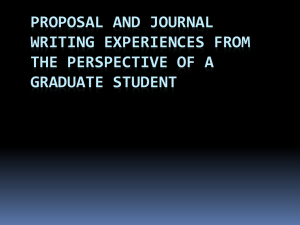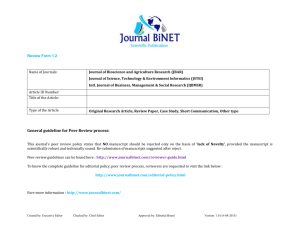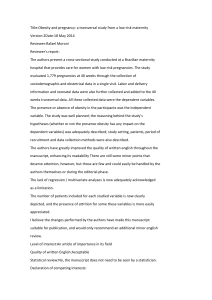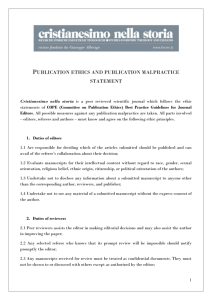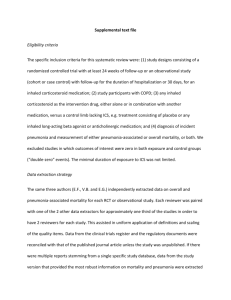DOC
advertisement
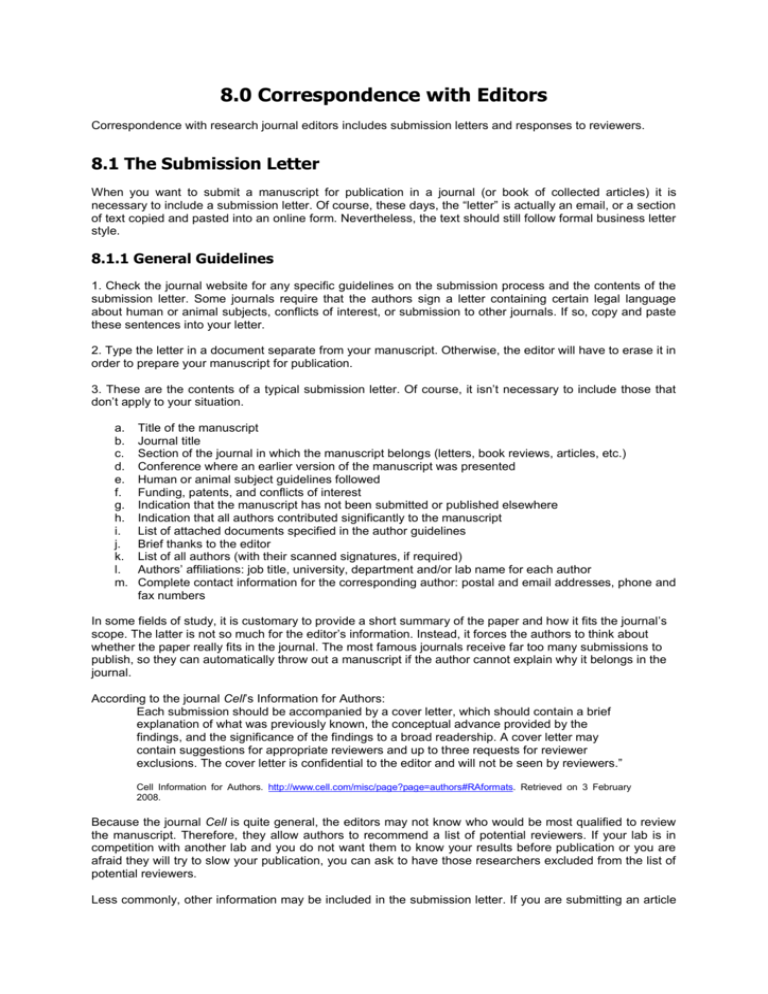
8.0 Correspondence with Editors Correspondence with research journal editors includes submission letters and responses to reviewers. 8.1 The Submission Letter When you want to submit a manuscript for publication in a journal (or book of collected articles) it is necessary to include a submission letter. Of course, these days, the “letter” is actually an email, or a section of text copied and pasted into an online form. Nevertheless, the text should still follow formal business letter style. 8.1.1 General Guidelines 1. Check the journal website for any specific guidelines on the submission process and the contents of the submission letter. Some journals require that the authors sign a letter containing certain legal language about human or animal subjects, conflicts of interest, or submission to other journals. If so, copy and paste these sentences into your letter. 2. Type the letter in a document separate from your manuscript. Otherwise, the editor will have to erase it in order to prepare your manuscript for publication. 3. These are the contents of a typical submission letter. Of course, it isn’t necessary to include those that don’t apply to your situation. a. b. c. d. e. f. g. h. i. j. k. l. m. Title of the manuscript Journal title Section of the journal in which the manuscript belongs (letters, book reviews, articles, etc.) Conference where an earlier version of the manuscript was presented Human or animal subject guidelines followed Funding, patents, and conflicts of interest Indication that the manuscript has not been submitted or published elsewhere Indication that all authors contributed significantly to the manuscript List of attached documents specified in the author guidelines Brief thanks to the editor List of all authors (with their scanned signatures, if required) Authors’ affiliations: job title, university, department and/or lab name for each author Complete contact information for the corresponding author: postal and email addresses, phone and fax numbers In some fields of study, it is customary to provide a short summary of the paper and how it fits the journal’s scope. The latter is not so much for the editor’s information. Instead, it forces the authors to think about whether the paper really fits in the journal. The most famous journals receive far too many submissions to publish, so they can automatically throw out a manuscript if the author cannot explain why it belongs in the journal. According to the journal Cell’s Information for Authors: Each submission should be accompanied by a cover letter, which should contain a brief explanation of what was previously known, the conceptual advance provided by the findings, and the significance of the findings to a broad readership. A cover letter may contain suggestions for appropriate reviewers and up to three requests for reviewer exclusions. The cover letter is confidential to the editor and will not be seen by reviewers.” Cell Information for Authors. http://www.cell.com/misc/page?page=authors#RAformats. Retrieved on 3 February 2008. Because the journal Cell is quite general, the editors may not know who would be most qualified to review the manuscript. Therefore, they allow authors to recommend a list of potential reviewers. If your lab is in competition with another lab and you do not want them to know your results before publication or you are afraid they will try to slow your publication, you can ask to have those researchers excluded from the list of potential reviewers. Less commonly, other information may be included in the submission letter. If you are submitting an article for publication for the first time without your advisor as a co-author, you may wish to mention your advisor’s name and the school and department where you earned your PhD. Alternatively, if another senior colleague has advised you to submit to a particular journal, you may mention this. However, in larger fields of scientific study, where everyone does not know each other, this is probably inappropriate. Additionally, you may have received a generally positive review from another journal, but your paper was rejected because it did not fit the journal’s scope. For example, the article was much too long or the topic of the paper was too theoretical or too practical for the journal’s readers. Perhaps the journal does not publish studies that use your methodology. In such cases, reviewers or editors sometimes recommend that you submit the paper to another particular journal. You can mention this recommendation in your submission letter. Finally, if you have used the same data for more than one analysis and have published or plan to publish more than one paper from the data, this should be mentioned in the submission letter. There is no strict rule for what percentage or what types of material from previous papers can be republished. In some fields of study, data should never be published more than once. In other fields, the same large dataset can be analyzed again and again in different ways to create new papers, and even shared among scholars from different labs. However, most fields fall somewhere in the middle. Consult a senior scholar for more advice. If you are honest about the content of previous papers and create genuinely new analysis for every paper, you should not have any trouble when you disclose the reuse of data. Attach a copy of the additional papers and highlight the sections that are reused. 8.1.2 Electronic Submission Submissions are now generally done via email or a submission website. When using a submission website, fill in the required information as requested. Provide any additional information in the submission letter and paste it into the electronic form. If it is required to scan signatures of the authors and there is no form provided, use the submission letter format. On the other hand, if there is no submission website with blanks to fill in, it is necessary to send a normal email. Very short submission letters could be sent as email. However, many journals specify that they would prefer an attachment. In this case, you can write the submission information in the format of a traditional business letter and attach it along with other requested documents to a brief email that simply includes the following: name of journal and manuscript title list of attachments (one attachment should be “Full Submission Letter”) brief thanks name of corresponding author with contact information 8.1.3 Comparison of Two Sample Letters Here is an example of part of the submission guidelines for a journal. Example of submission guidelines From the Asia Pacific Journal of Clinical Nutrition Instructions for Authors: Covering letter Papers are accepted for publication in the journal on the understanding that the content has not been published or submitted for publication elsewhere; a statement indicating the paper's originality should be included. This must be part of the covering letter. Authors must also state that the protocol for the research project has been approved by a suitably constituted Ethics Committee of the institution within which the work was undertaken and that it conforms to the provisions of the Declaration of Helsinki in 1995 (as revised in Edinburgh 2000). All investigations on human subjects must include a statement that the subject gave informed consent and patient anonymity should be preserved. Any experiments involving animals must be demonstrated to be ethically acceptable and where relevant conform to National Guidelines for animal usage in research. Submission The manuscript and other required documents including a completed Copyright Assignment Form (see below) should be emailed as attachments to: apjcn-apcns@umail.hinet.net Professor Mark L. Wahlqvist Editor-inChief: Asia Pacific Journal of Clinical Nutrition http://hec.server101.com/APJCN/Authorinstruct.pdf Two examples follow. The first contains several errors. The second is a corrected version. X Example with Errors: Cover Letter 08/10/07 Dear Professor Mark L. Wahlqvist, First of all, I want to thank you for taking the time to review my manuscript. I understand that this is a very long and difficult process for you. So, I have taken careful consideration and have done my best to improve my manuscript to meet your revisions. We submit the manuscript entitled “Food security, selection, and healthy eating among various age cohorts in a coastal community of South Korea.” This study was presented at the Association of Clinical Nutrition meeting last year, but has never been published nor submitted to any other journal. Our study protocol conforms to the human subject guidelines of the Hanyang University Institutional Review Board and to the provisions of the Declaration of Helsinki in 1995 (as revised in Edinburgh 2000). Subjects provided informed consent and their anonymity should be preserved. Our study was funded by the Brain Korea 21 fund. We have no conflicts of interest. Sincerely, Chan-ho Park Dr. Chan-ho Park, MD, PhD corresponding author Hanyang University, Seoul O: 02-2220-0000 HP: 016-0000-0000 Dr. Sun-woo Kim. MD Hanyang University, Guri Dr. Hee Seop Choi, PhD Hanyang University, Seoul Errors The title “Cover Letter” is not needed. The date is ambiguous. It may be August 10 or October 8. Use a form that can be understood internationally, such as “8 October 2007.” 3. The greeting should include only the title and family name of the editor: “Dear Professor Wahlqvist.” It should be followed by a colon (:) (American) or no punctuation (British). 4. The first paragraph is inappropriate for several reasons. It should be cut entirely. a. The appreciation goes on in too much detail, which may feel awkward to a North American or European reader. b. Also, the expression “have done my best” sounds like children’s language in this context. It is expected authors should do their best, but it is unnecessary to mention it. c. It wouldn’t be a good idea to tell the editor that “this is a long and difficult process.” He or she may feel that the writer is saying that the editor is not qualified to do this work easily. A better expression would focus on time, not difficulty. Example: “Thank you for putting so much time into the improvement of my manuscript.” d. There are some language errors as well. “taken careful consideration” requires “of [something]”. “Meet revisions” also doesn’t make sense. The correct expression would be “to meet your requirements” or “in light of your recommendations.” e. The use of “I” is incorrect, because there are three authors. f. The introductory phrase “first of all” is too informal. Just “first” is more appropriate. g. Using “so” at the beginning of a sentence is informal style and should be limited to email with close friends. A better choice: “therefore.” (Note: the same rule applies to “and,” “or,” and “but.”) 5. The title of the journal is missing. If this editor manages several journals, this may be a problem. Also, it would be best to mention the section of the journal in which the article belongs (letters, book reviews, articles, etc.), if the journal has sections. 6. The letter needs a closing. Here is one option: “Thank you for your consideration. We look forward to your response.” 7. Periods (.) are not necessary after the authors’ names. 8. “Dr.” is not needed before the authors’ names. The degrees listed after the names provide the same information. “Dr.” and “Professor” are titles usually used for addressing another person. Do not use them to describe yourself. 9. The fax and phone number plus email and mailing addresses of the corresponding author should appear either under the corresponding author’s name or in the body of the letter. 10. The phone number should include the country code. 11. Avoid using abbreviations such as “HP” (hand phone), which are unique to Korea. Instead, write out “Mobile” and “Office.” 12. All authors’ names should be listed in the submission letter, and all of them should sign it. If there is electronic submission, the journal may require a separate document with signatures to be scanned and sent. 1. 2. O Corrected Example: 08 October 2007 Dear Professor Wahlqvist: We submit the manuscript entitled “Food security, selection, and healthy eating among various age cohorts in a coastal community of South Korea” for publication in the “Research Articles” section of the Asia Pacific Journal of Clinical Nutrition. This study was presented at the Association of Clinical Nutrition meeting last year, but has never been published nor submitted to any other journal. Our study protocol conforms to the human subject guidelines of the Hanyang University Institutional Review Board and to the provisions of the Declaration of Helsinki in 1995 (as revised in Edinburgh 2000). Subjects provided informed consent and their anonymity should be preserved. Our study was funded by the Brain Korea 21 fund. We have no conflicts of interest. Thank you for your consideration. We look forward to your response. Sincerely, Chan-ho Park Chan-ho Park, MD, PhD corresponding author Hanyang University, Seoul 17 Haengdang-dong, Seongdong-gu Seoul, Korea 133-791 chanhopark@hanyang.ac.kr Office: (82) 2-2220-0000 Mobile: (82) 16-0000-0000 Fax: (82) 2-2220-0001 Sun-woo Kim Sun-woo Kim, MD Hanyang University, Guri Hee Seop Choi Hee Seop Choi, PhD Hanyang University, Seoul 8.2 The Response to Reviewers A response to reviewers is a reply to each comment that your reviewer(s) wrote about your manuscript. When you submit a manuscript for publication, there are four possible responses from the journal editor: 1. Acceptance with minor revisions Almost no papers are accepted without any revisions. However, in a few cases, you may be able to make just a few small changes. If you receive this response, make the revisions and return the manuscript immediately for publication. Include a response to reviewers that lists each change made. Very minor grammatical changes can also be marked in the text itself. Turn on the “track changes” feature so that your changes will be automatically highlighted. In Microsoft Word, click “Tools” “Customize” “Toolbars” “Reviewing.” (도구 사용자 지정 도구 모음 검토) 2. Acceptance with major revisions This situation is quite common. A long response to reviewers should accompany your revised manuscript. Detail each major change. 3. Rejection, but with invitation to resubmit The authors should not give up in this case. The paper seems to be worth publishing, but the editor cannot promise anything because it depends on the quality of the revision. Carefully consider the advice of the reviewers and if you feel comfortable taking much of their advice, go ahead and rewrite the paper and submit again. Often, the editor will ask for a shorter version of the paper. Try to meet the editor’s word limit. 4. Rejection There are two main reasons a paper will be rejected. One is that the paper does not fit in the journal or the journal simply has a long waiting list for publication. In this case, follow any recommendations of the editor and locate a better journal. The other reason a paper may be rejected is that the basic methodology of the study or basic theoretical argument is invalid according to the standards of the field. If you realize that your study was truly flawed, it may be impossible to save the manuscript, unless it is a simple matter of doing additional procedures, increasing the sample size, etc. On the other hand, it is possible that the study would be considered valid in a different subfield. For example, a qualitative study may not be objective enough for one journal, but another journal regularly publishes qualitative studies. In theory, it is possible to argue with the editor about a rejection. However, it is usually unsuccessful, so the best response for junior scholars is generally to submit to a different journal. 8.2.1 How to organize the response to reviewers 1. The response to reviewers is a letter. Format it like a business letter, with a greeting and closing, date, etc. 2. Copy and paste each comment of one reviewer into a fresh document. Type your answer after each one. 3. If several reviewers made the same comment, it is not necessary to type a full response to each reviewer. Group the comments by several reviewers at the beginning of the document. Alternatively, respond only to the first reviewer. After the second reviewer’s similar comment, simply type, for example, “Refer to our response to Reviewer 1 Comment 5.” 4. If your response contains many citations, include a reference list at the end, just like the reference list of a research article. 8.2.2 Types of Responses to a Reviewer’s Point 1. Simple agreement to a reviewer’s suggestion. A reviewer may suggest that you add information, run additional statistics, do an additional procedure, or expand a sample size. If you agree with the reviewer’s suggestion, follow these steps: a. Refer to the page and/or line number of the text changed to support the reviewer. b. Highlight the changed text in a different color. c. Copy and paste the added text into the response to reviewers (unless it is very long). d. Use the phrase “we agree.” Don’t add a lot of extra commentary to the agreement. (X: “Thank you for your suggestion. It was very helpful.”) e. If the reviewer suggested running additional statistics or doing an additional procedure, describe what you did in detail in the response to reviewers. f. It is not always necessary to include the results of the additional procedure in your paper, if they seem unimportant to your argument and just prove the point you have already made. It is enough to put the results in your response to reviewers. (Ask a senior scholar for advice about this if you are uncertain.) 2. The reviewer does not understand part of the paper and makes an unhelpful suggestion. (In other words, you are certain that you are right and the reviewer is wrong.) Politely restate the points that the reviewer did not understand. Try to explain it more simply and with more context, assuming that the reviewer may not have the same background knowledge that you have. Don’t be afraid to reject bad advice. If you are uncertain about the quality of the advice, consult with a senior scholar. 3. The reviewer makes a good suggestion, but you already decided not to follow that plan for a good reason. There are many reasons that you may not follow reasonable advice. For example, the word limit may prevent you from exploring a topic in more detail in your discussion section or adding many new citations. Often the suggestions can be used for designing a follow-up study. If you plan to follow the advice in a later project, indicate so. Tip: It is common for a reviewer to criticize parts of your paper. If you are a junior scholar, do not assume that the reviewer is wrong. Speak with a senior colleague who understands your research well, and get another opinion before rejecting a reviewer’s suggestion. Rejecting advice too easily may prevent you from publishing your paper (Sung-Tae Hong, personal communication). 8.2.3 Examples from a Real Response to Reviewers The following excerpts come from a response to reviewers posted on the internet. The research is about levels of mercury (Hg) exposure through eating various types of fish. The manuscript was written by research staff from the U.S. FDA (Food and Drug Administration) and EPA (Environmental Protection Agency). Because this work was done by government staff, the reviewers’ comments and authors’ responses were made public. The reviewer suggests that the author use a different method. The authors show their agreement with part of the reviewer’s comments. “We think this is appropriate” is a polite way to disagree. “For current purposes” limits the value of the authors’ method to this study, implying that the reviewer’s method could also be useful in other situations. Comment: “The model uses a simplified relationship to estimate mercury blood levels from intake rather than incorporating a pharmacokinetic model to estimate blood levels. There is a simple one compartment model that provides reasonable predictions of mercury blood concentrations from acute and chronic intake information (e.g., Stern, Reg. Tox. Pharmacol. 25: 277-288, 1997; Ginsberg and Toal, Risk Anal. 20: 41-47, 2000). This pharmacokinetic model has the advantage of employing a range of parameter inputs that will create a distribution of blood levels for any intake level that will better represent population variability than the current FDA approach. That approach does not really take into account inter-individual variability in pharmacokinetics.” Response: The model is simplified relative to the Stern model in that it assumes steady state kinetics. Given the fact that most toxicological analyses (including the RfD derivation) make the assumption that chronic exposure is the relevant dose metric, we think this is appropriate for current purposes. However, it is not true that population variability is not represented – a distribution is employed which is derived from the Sherlock et al, 1984 study. This distribution is somewhat narrower than the Stern model – this result is attributable to the assumption in the Stern model that blood levels are directly proportional to dose and body weight. It is likely that this assumption causes the Stern model to overestimate pharmacokinetic variability. In the end, the authors disagree with the reviewer, but provide polite detailed reasons for their perspective. Beyond defending their own method, they describe the problems with the reviewer’s suggested method. This allows the editor to decide whether the authors’ perspective is worth publishing. Before disagreeing, the authors provide a reason. “Given the fact that” introduces the reason. The authors now defend the value of their method, citing a paper that explains in more detail. The reviewer suggests that the authors do additional work. Comment: “Regarding model limitations, the authors note in their Risk Analysis paper that species consumption patterns for each consumer may be more highly correlated than is specified in the current model. Some additional exploration with sensitivity analyses would be useful.” The authors agree directly with the reviewer when possible. The authors provide more specific details of how they would follow up on the reviewer’s suggestion. Response: We agree that additional work could be done in this area. In particular, the 30 day fish consumption frequency data can be used to capture the variation among individuals of the variation in seafood consumption habits. It does appear that some frequent seafood consumers eat one particular species consistently, while others eat a wide variety. These data may provide a basis for differentiating the degree of interindividual vs intraindividual variation on a species by species basis. We are working on a model that is more closely integrated with the NHANES survey. But, the authors don’t agree to do more work for this manuscript. They will publish the additional analysis as a separate paper. The authors use the term “agree” to be polite, but are actually disagreeing with the reviewers indirectly. The authors say that advice to the public should include omega 3 fatty acid content and PCB contamination of fish, but the paper is good enough without this information. The reviewer suggests that the authors use a more complex method that would require substantially more work. Comment: Two reviewers felt that analyses should consider risk trade off by considering the omega 3 fatty acid content of fish species. It was also noted that analyses, and presumably the EPA/ FDA fish advice, should consider PCB contamination of fish. Response: We agree that the ultimate fish advice (and the scientific basis thereof) should include these factors. This is, however, much beyond the scope of the current analyses. The reviewer suggests that the authors include some additional statistics. Comment: A scenario should be included that reflects no The authors highlight the fact that they have included similar statistics in their paper. consumption of albacore [참치] (as opposed to no consumption of medium group fish. Response: The current draft of the manuscript for publication includes a scenario that limits consumption of albacore to 6 oz., but does not include one with no albacore consumption. We expect that elimination of albacore consumption will have a very minor effect on the blood mercury predictions. Next, the authors argue that including the additional statistics suggested by the reviewer would be redundant. US FDA and EPA. An Intervention Analysis of Exposure to Methylmercury. for Consumption of Seafood. To view the entire response to reviewers, scroll down to Part III: http://www.fda.gov/ohrms/dockets/ac/03/briefing/4010b1-12-%20EPA.htm . Retrieved in October 2007. 8.2.4 Finding Useful Expressions from Sample Letters When writing your response to reviewers, you may wish to collect common expressions from sample letters online or borrowed from senior colleagues. Here is an example. Follow the internet link below to see more examples. The underlined portions can be copied and pasted into your own writing, if they are appropriate to your context. This is an excerpt from a response to reviewers in nursing. It is very well-written. In particular, every answer is concise and to the point. (“P” stands for “page” and “L” stands for “line.”) Example: The introduction was rewritten to address the reviewer’s concerns. The question is now clearly stated on P3L2-6, the Needleman reference is removed, and the problem is discussed in greater length on P3-4. Nursing Research. Sample Response to Reviewers Comments. editor.com/authors/OMR/20/OMRAuthorResponses.pdf . Retrieved in October 2007. http://www.nursing-research- 8.2.5 Dealing with Problematic Situations in the Review Process Here are some potential problems and recommended solutions. 1. Without adding any comments, one of the reviewers simply recommends the paper for rejection or acceptance without revision. Neither of these is good for you. Usually in this case, the reviewer was lazy and did not give you a proper review. In almost 100% of manuscript submissions, there is some way to improve the first draft before publication. Publishing the paper without a thorough review risks the possibility that you will publish an error that others will notice and critique in a letter to the editor or even in another journal article. More likely, if readers recognize a major error, they will avoid citing your paper. To avoid this embarrassment, take your paper to a senior colleague you trust to give you an informal review if you feel that the reviewers did not provide sufficient advice. 2. The reviewer does not understand the paper, or focuses only on one section that he or she understands. This is an embarrassing situation for the reviewer. Avoid attacking the reviewer’s errors. However, it is appropriate to disagree with the reviewer’s points and provide evidence for your perspective. For smaller journals, you may also wish to contact the editor and explain that the reviewer seems to be coming from another field of study and you would like an additional review. You may even suggest the names of some reviewers who know your field well. Before doing this, check with a senior colleague to verify that your analysis of the situation is correct. 3. The reviewer tries to proofread the paper, focusing on grammar instead of content. Sometimes grammar errors can make sections of your paper unclear. In this case, it is appropriate for the reviewer to point out parts of the paper that are difficult to read. Whenever possible, send your manuscript to the Writing Lab before submission. We will point out ambiguous sentences so that you can revise them and the reviewer can focus on your ideas, not your language. Other times, there may be no major English errors, but the reviewer is lazy and focuses on grammar instead of content. This is quite common. Sometimes the grammar is virtually perfect, but the reviewer still tells the author to correct grammar errors. Don’t be discouraged about your English and don’t necessarily believe the reviewer’s opinion about your English. Simply get some assistance and return the revised paper. 4. Two or more reviewers give opposing recommendations on revising the paper, and it is impossible to satisfy everyone’s expectations. This is quite common and, although inconvenient, should not be a cause for great concern. First, think through the different perspectives carefully. Is one perspective well thought out while the other is not a careful analysis? If so, simply follow the better advice. Respond politely to the other reviewer’s suggestions, providing reasons for rejecting each suggestion. Do the two reviewers seem to look at the paper from the perspectives of different research areas? If so, consider how these two research areas fit with the goals and audience of the journal. Does one seem removed from the main audience of the journal? For a specialized journal, the editor is likely to represent the mainstream views of that research area and support the reviewer with similar opinions. Then, you have two options: reshape your paper to fit the conventions of the journal or provide a good argument to the editor of why you will follow the conventions of another field of study. If both reviewers’ perspectives seem worth considering, show your paper to a senior colleague, then contact the editor for further advice. After doing this much work, the editor will be very motivated to publish your paper if possible and will usually try to help you resolve the situation. Keep in mind that the editor will not necessarily require you to follow all the advice of the reviewers, particularly if space is too limited. 5. The reviewers recommend that the paper be accepted after extensive revisions and provide long lists of suggestions. This is not a problem! Actually, this is the best possible situation. Many of the suggestions will probably improve your manuscript. Those that don’t can be politely rejected. In the end, your paper will likely be published. 8.2.6 Business Letter Format Greetings Dear [Title] [Family Name]: Dear Dr. Brown: In formal writing, use a colon (:), not a comma, in American English. For British English, no punctuation is needed. Dear Professor Brown: Do not include the full name in the greeting. Also, do not include the word “Editor.” Do not address the letter to the journal (X: Dear Journal of Pediatrics). If you don’t know the name of the editor, look it up, and if you still cannot find it, use “Dear Sir or Madam.” Closings Capitalize the first word of the closing, but not any additional words. Leave one line before and three lines after (for a handwritten signature) or one line after (for only a printed name). American English: Just use “Sincerely” for all formal letters. It is followed by a comma (,). British English: Yours sincerely, yours truly, and several other expressions are possible. A comma (,) is optional. Note: It is not necessary to use the editor’s own English dialect (British, Australian, etc.) in your correspondence. For your own convenience, choose a standard and use it consistently in every letter. This will allow you to copy and paste unique details into a form letter that you can use again and again. Names When submitting to a journal outside of Asia, write your name with your given name first and then your family name in the cover letter, but type names according to the journal style in the manuscript. Unlike in Korea, it is generally uncommon to capitalize all the letters of a family name (e.g., Maria BROWN). Although you may wish to do this in local correspondence, it is not recommended in international correspondence. Dates Use a form of the date that is clear internationally. “9/10/07” is September 10 in North America and October 9 in Europe. One solution is “9 October 2007.” 8.2.7 Tips for Professional Email Correspondence 1. Create a professional email signature that includes your phone number, email address, and current job title or department and university name. You may also want to include your mailing address. Use it every time you send an email, even for people who already know you. Example: Jocelyn Graf Assistant Director English Writing Lab Hanyang University Seoul, Korea jocelyngraf@gmail.com Office: (82) 1-111-1111 Mobile: (82) 2-2222-2222 2. 3. 4. 5. 6. 7. If your email name is not professional, create an extra email account with a more formal name. Check it often or set it up to deliver to your main email box. In Western culture, cute or funny names are not as acceptable as in East Asian culture. They may also be confusing for English learners from other parts of the world. Use a relatively formal style for all professional correspondence, even if someone answers you in an informal style. Never use emoticons ^^, CAPITAL LETTERS, or exclamation points (!) in any professional email. Follow submission guidelines about which file types to use and whether to zip files. When someone sends you an email that contains information, but you do not have to respond, do so anyway. Otherwise, the sender will wonder whether you received it. A simple answer, such as “Thank you,” is enough. Use a relevant, specific subject line. Never use subject lines such as “hello”, “manuscript,” or “question” that appear to be spam. Better options are “Manuscript Submission to Nature” or “Request for Confirmation of Submission.” 8.2.8 How to Address a Formal Email or Business Letter 1. In the first contact with someone, use a formal greeting. “Dear” plus the individual’s title (Mr., Ms., Dr., etc.) and the family name. 2. In North America, there are not many titles. Individuals who are not doctors, religious leaders, or politicians usually go by “Mr.” or “Ms.” Even if someone’s business card says “Director,” do not address the individual as “Director Smith.” 3. For women without a special title, such as “Dr.,” use “Ms.” Do not use “Miss” or “Mrs.” unless a woman specifically requests it. 4. When contacting professors and university staff, use “Professor” if you are not sure whether the individual has a Ph.D. (or other doctoral degree). 5. Even if writers sign their names informally, continue to use their formal titles until they ask you to call them by a given name or nickname. For example, if a professor signs her email to you as “Sarah,” you should still reply to her as “Professor Smith.” 6. Do not include the given name in the greeting. X: Dear John Smith: X: Dear Mr. John Smith: Definitely do not use the given name alone with the title. Only young children use this form in North American culture. X: Dr. Mr. John: Exception: If you are not certain whether someone is a man or woman because the name is unfamiliar, use the whole name after the title. This is also a good strategy when you do not know which name is the family name and which is the given name. Dear Jin Yi: Dear Lakshmi Kumar: Dear A.J. Washington: If you build a professional relationship with this person and still do not have this information, call the department and ask the secretary or look for more information online. If necessary, you can ask the individual directly in the second email. 8.2.9 Recommended Reading These two articles provide more detailed advice about writing responses to reviewers: Millett D. Dealing with reviewers’ comments? J Orthod. 2006 Jun;33(2):69-70. Available from: http://jorthod.maneyjournals.org/cgi/reprint/33/2/69 Cummings P, Rivara FP. Responding to reviewers' comments on submitted articles. Arch Pediatr Adolesc Med. 2002 Feb;156(2):105-7. Available from: http://archpedi.ama-assn.org/cgi/content/full/156/2/105 Here is an excellent article that describes the whole process of publication from an editor’s perspective: Samet JM. Dear author—Advice from a retiring editor. Am J Epidemiol. 1999 Sep 1;150(5):433-6. Available from: http://aje.oxfordjournals.org/cgi/reprint/150/5/433
